Summary
Louis Pasteur is the renowned chemist and microbiologist of the 19th century involved in the development of the rabies vaccine. He worked with a researchers team in the laboratory, mainly Pierre Paul Emile Roux, and also physicians in the clinical practice approach and the defense of Pasteur’s anti-rabies technique in the Académie Nationale de Médecine, Alfred Vulpian being the most notable. Pasteur’s first studies on rabies are noted in his 1881 publication. But in 1885, he revealed that he had already immunized 50 dogs against rabies. Meanwhile, he was looking for human subjects. The most polemic of this search involves the second and last Emperor of Brazil, Dom Pedro II, who was a patron of the arts and sciences and followed and supported the work of the great scientist. During the reign of Dom Pedro II, the first Pasteur’s Institute was founded in Rio de Janeiro, nine months before the Parisian, which had the financial support of Dom Pedro. This article deals with the interaction between the two outstanding characters, especially in the development of prophylactic treatment against rabies, and with the utilitarian aspects of this vaccine researches development against individual autonomy.
Keywords: Rabies vaccine, History of medicine, Institut Pasteur
Introduction
In 1884, Louis Pasteur (Fig. 1), from Paris, asked the Brazilian Emperor Dom Pedro II (Fig. 2) to authorize the use of anti-rabies vaccine trials in prisoners sentenced to death in the South American country. Though the disturbing fact is that the rabies vaccine had so far only been tested on dogs by Pasteur, and the request involved imprisoned, subjugated, and vulnerable subjects, not at risk of developing rabies previously the vaccination.
Fig. 1.
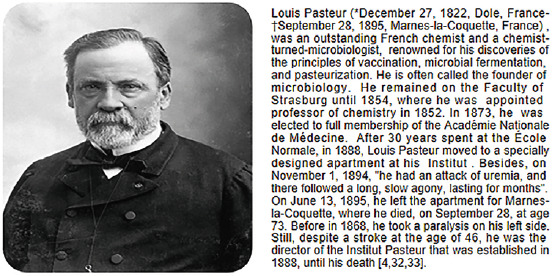
French scientist Louis Pasteur (1822-1895), 1878, by Paul Nadar (1856-1939). Source: Wikimedia Commons [4, 32, 33].
Fig. 2.
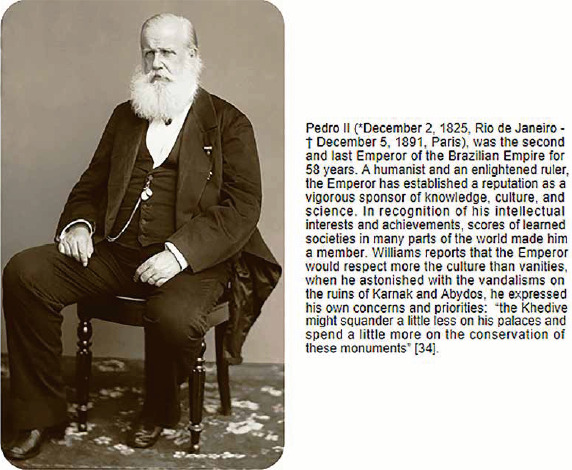
Retrato de D. Pedro II of Brazil, 1885, by Marc Ferrez, Rio de Janeiro, RJ/Acervo IMS [34].
Rabies is a zoonotic, acute, progressive, and incurable viral infection of the central nervous system, caused by a neurotropic RNA virus (family: Rhabdoviridae; genus: Lyssavirus). This virus infects domestic and wild animals, and the disease is transmitted to other animals and humans through close contact with saliva from the infected animals. This is an old and feared disease by humanity. However, it is still widely distributed, especially in developing countries where the burden caused by rabid dogs continues [1]. The clinical rabies mortality is virtually 100%; however, the hazard of acquiring the disease by the rabid animal bite is much less [2].
Regarding the main types of virus, there is a street virus that comes directly from the central nervous system of a naturally infected host and fixed virus, been adapted through a passage in the brains of experimental animals and cell culture. The incubation period and biological behavior of the street virus are inconstant in humans, usually a long incubation period but a rapid evolution: 80% presents the classic form of the disease (furious rabies, “hydrophobic” or “spastic” form), and 20%, a paralytic form (dumb rabies, “tranquil” or “paralytic”) [3]. This last one presents with an ascending paralysis of Landry type, ending in bulbar, respiratory, and encephalitic symptoms [4]. Despite the severity of the clinical symptoms, rabies caused by the street virus has relatively mild meningoencephalitis neuropathologic changes characterized by inflammatory alterations occurring predominantly in the gray matter. In the paralytic form of the disease, the most striking pathological changes are seen in the spinal cord, with neuronal degeneration in the anterior horn resembling poliomyelitis [3]. However, the pathognomonic feature of rabies is represented by the occurrence of intraneuronal protoplasmic inclusions, the Negri bodies, most frequently found in the pyramidal neurons of the hippocampus and the Purkinje cells of the cerebellum. This rabies hallmark was defined by Adelchi Negri (1903) in Golgi’s laboratory [3].
This paper deals with the development of the rabies vaccine by Louis Pasteur, and the observance of it by the Brazilian Emperor, Dom Pedro II, as a savant ruler.
At Pasteur’s time, he had to face opposition regarding the anti-rabies vaccine development, as he was not a physician, as well as, he suffered the resistance of the antivivisectionists because of the animal experimentation, but also of the antivaccinationists. It is still a matter of debate on the “Trolley dilemma”, which refers to the question of sacrificing some for the benefit of many – a central issue in the dilemmas of vaccination tests [5]. However, this utilitarian theory, which justifies human losses to achieve progress in science and economic gains, was widely disseminated but also criticized.
The foundations of the Institute Pasteur of Rio de Janeiro and after of Paris are presented. Besides, a letter written by Louis Pasteur to Dom Pedro II about his needs for human Guinea pigs is studied from the current bioethical point of view.
The friendship between Dom Pedro II and Pasteur
Dom Pedro II demonstrated precocious interest in Pasteur’s work since the beginning of the decade of 1870. Indeed, at this time, Pedro II informed Count Gobineau, former French Minister to Brazil, of his desire to know the great scientist. This meeting was carried out in the laboratory of the École Normale when the Emperor was visiting Paris for the first time [6]. Indeed, Dom Pedro II, on several occasions, recognized the greatness of the researcher and even honored him. On 06/16/1886, Pasteur sent a letter to the Minister of the Empire, Baron de Mamoré, thanking him for the notification of his appointment as Grand Cross of the Order of the Rose. Still, he had already been appointed Commander of the same Order in 1872 [7].
The interaction between these two distinguished men was shown through their correspondence to each other [8]. The letters sent by Pasteur to D. Pedro II are collected at the Museu Imperial, and they are essential to understand the development of the rabies vaccine and Pedro II’s concern about yellow fever [9-15].
On 11/15/1880, Pasteur, in his letter to Pedro II, deals with yellow fever and says that he is sending the work Critical review of posthumous writing by Claude Seward on fermentation [9]. On 07/07/1882, Pasteur talks about the need to study yellow fever in a country where it had its origin and regrets not being able to come to Brazil for reasons of health and age. Pasteur also addresses rabies, whose study he was currently engaged in [10]. In other letters of 6/23/1884 and 9/22/1884, Pasteur requested the collaboration of the Emperor to erect a statue in honor of Monsieur Dumas, in Alais, his hometown. In the other important letter, he addresses rabies, cholera, and the rabies vaccine. He mentions that he intended to come to Rio de Janeiro to study the subject, especially the contagion and the medicines that should be used. In the draft of the reply, the Emperor says that Pasteur’s visit to Rio de Janeiro could provide an excellent service to humanity, but bringing the latest news about the studies of yellow fever [11]. In the letter of 2/23/1885, Pasteur refuses the invitation made by the Emperor to come to Brazil to study yellow fever [12].
Later, Pasteur also gives the Emperor knowledge of a note on studies of rabies presented by him in the Académie des Sciences (03/02/1886) [13]. Another presentation at the same Academy is commented on studies of rabies treatment. The scientist also talks about the purpose of establishing an anti-rabies study center in Brazil, and he considers that dr. Ferreira Santos would be perfectly capable of founding it (11/03/1886) [14].
The first Pasteur’s Institutes
The first Pasteur Institute was opened on February 25, 1888, in Rio de Janeiro, nine months before the French one (Fig. 3) [15]. Its constitution was a masterly feat for having faced obstacles of the most varied natures [15].
Fig. 3.
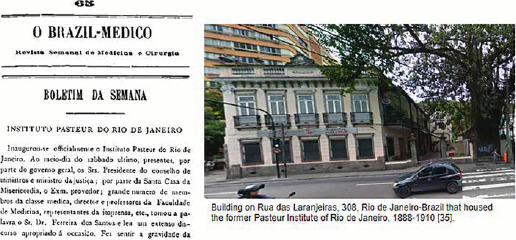
Pasteur’s Institute of Rio de Janeiro, responsible for preventive rabies vaccination where the first rabies inoculation was carried out in Brazil. It was the world’s first Pasteur’s Institute, established nine months before the Parisian one. The Institute was installed in a building previously owned by Viscondessa de Araújo, but bought by the Provider of the Santa Casa de Misericordia [15]. Its inauguration was acclaimed and registered at the Brazil-Médico [35].
The Journal O Brazil Médico [16] welcomed the initiative of this foundation and highlighted its dependencies with a bacteriology laboratory very well equipped with devices and instruments imported from Europe, suitable for investigations related to other diseases besides rabies. However, this Institute became restricted to the production and application of the rabies vaccine. The first director of it was the Brazilian forerunner to study with the Pasteur’s group in Paris: Augusto Ferreira dos Santos. He was a professor of mineral chemistry at the Faculty of Medicine of Rio de Janeiro.
During the trip back from the “City of Light”, dos Santos made the intracerebral passage of the virus from the three rabbits inoculated in Paris that fell ill on board, to normal rabbits. This was done to implement the rabies vaccination in Rio de Janeiro. The next passage of the virus took place shortly after he arrived in Rio de Janeiro, on July 23 and 24, in temporary facilities at the pharmaceutical laboratory of Santa Casa de Misericórdia [15].
On February 9, 1888, still in Santa Casa de Misericórdia, a range of rabbit marrows subjected to desiccation was complete, when the first anti-rabies treatment in Brazil was started for a patient supposed of having been diseased with the rabies virus, a girl by the name of Isolina Torres [15].
Concerning the Pasteur’s matrix Institute, D. Pedro II was one of those who contributed a large amount for its creation, as expressed at Le Figaro [17] (Fig. 4).
Fig. 4.
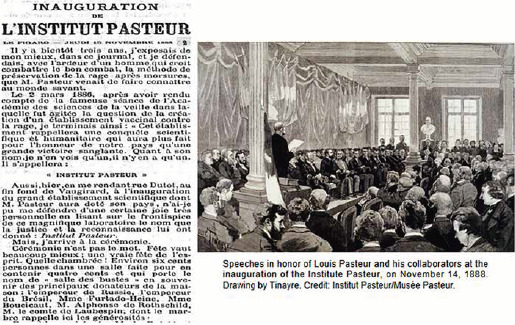
Inauguration of the Pasteur’s Institut, on November 14, 1888. The Institute found by Pasteur also contains busts of all benefactors of the Institute at the time of its inauguration of Pasteur, Don Pedro, Alexander III, Mme. Furtado-Heine, Mme. Boucicaut, M.A. de Rothschild and the Count de Laubespin. Its inauguration was acclaimed and registered at “Le Figaro“ [17].
Pasteur, in a letter to Dom Pedro II, of 4/14/1888 and 11/28/1888, was pleased to know that the Rio de Janeiro Anti-rabies Institute was in operation. He thanked the 12 photographs of the Rio de Janeiro Anti-rabies Institute that would be displayed in one of the rooms of the Parisian Pasteur’s Institute. Besides, he talked about the inauguration and news of the French Institute [18].
The rabies vaccine and human subjects
The nineteenth century was a significant landmark in the history of vaccines since it witnessed discoveries made by Louis Pasteur, the father of microbiology, and many others [19] such as Pierre-Victor Galtier and Paul Gibier. Galtier, professor at the Lyon Veterinary School, was the precursor of rabies vaccination (1879-1881): I inoculated, seven times rabies saliva in the sheep jugular without ever getting rabies, apud Mérieux [20]. This was not yet a vaccination but a “variolation” [21]. Besides, Paul Gibier from the Faculty of Medicine and the Muséum d’Histoire Naturelle de Paris showed in 1883-1884 that the rabies virus lost virulence after desiccation and that this approach could be used in humans [22]. In this way, Pasteur began to work on rabies vaccine in this already vibrant and dynamic research background, as we see in the next section.
Now, we come back to the most famous letter from Pasteur to Dom Pedro II [11], presented in Figure 5, and excerpts below.
Fig. 5.
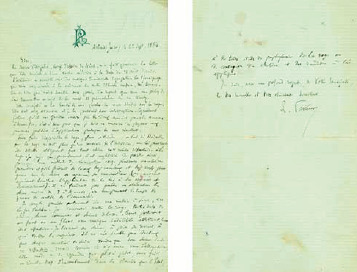
Letter from Pasteur to Dom Pedro II, asking the Emperor to allow him to test the vaccine against rabies in those sentenced to death. Credit: Arquivo Histórico - Museu Imperial, Maço 192 - Doc. 8722, 23/06 e 22/09/1884 [11].
Pasteur urged to follow a next delicate step “when Guinea pigs are human” [23]: But even though I have multiplied the examples of rabies prophylaxis in dogs, it seems to me that my hand will tremble when I have to move to the human species.
It is clearly shown that scientific research in the biomedical field has been developed with experiments. However, at Pasteur’s time, there was already an ethical limit for human experimentations, at least from the theoretical point of view. Simonds, in his book on medical deontology (1845) [2], recommends that the experiment would be allowed on limited occasions in desperate cases. Still, physicians would have to avert inhuman procedures or anything which might reduce the patient’s life or impede even simple palliative resources. Besides, it is well known that there was not always a distinction between human and animal subjects. If certain classes of people were not considered socially relevant according to the moral appreciation of the time, against individual autonomy, they would be used in research, as Pasteur propose: … If I were king or Emperor or even president of the republic, here is how I would exercise the right of pardon on death row inmates. I would offer to the lawyer for the convicted person, the day before the execution of the latter, to choose between imminent death and an experiment which would consist of preventive inoculations of rabies to cause the constitution of the subject to be refractory to rabies . Employing these trials, the life of the condemned man would be saved. If it were, and I have the persuasion that it would indeed be, – as a guarantee vis-à-vis the society which condemned the criminal, it would be subjected to surveillance for life.
All the condemned would accept. The death row inmate only apprehends death.
In response, Pedro II made a declined alternative suggestion to study yellow fever in loco because of the more significant social benefit [11].
However, Simons (1845) [2] already recommends that: The most obscure patient, the most useless to society itself, cannot be subjected to experiments, which would obviously put his life in danger: perish science rather than such a principle!
Indeed, the current system of human-subject-research oversight and protections has developed relatively in recent times, and their principles were first developed referring to the Nuremberg code to try Nazi war criminals [24]. At this time, the three elementary fundamentals of the Nuremberg Code (voluntary informed consent, favorable risk/benefit analysis, and right to withdraw without repercussions) turn out to be the groundwork for succeeding ethical codes and research conventions.
However, Pasteur was not isolated in this enterprise, for Pierre Paul Emile Roux, a physician at his basis, had also made crucial aids to the experiments with rabies inoculation in a variety of laboratory animals [25].
Louis Pasteur’s works on rabies
Louis Pasteur wrote the first of his papers on rabies, in 1881 [26], with the collaboration of Chamberland, Roux, and Thuillier: We have started studying rabies.
In a publication in 1884 [27], he Previously demonstrated that, in cases of rabies, the rabies virus had its seat in the brain and the spinal cord. We have looked for it more recently in the nerves proper and in the salivary glands. In other publication of the same year (1884) [28], Pasteur report: If we go from dog to monkey and later from monkey to monkey, the virulence of the rabies virus weakens with each pass. Consequently, Pasteur created an attenuated vaccine, and efficaciously immunized inoculated dogs.
In a next report (1885) [29], Pasteur approach Method to prevent rabies after biting, and he says that Out of twenty dogs treated, I could not have responded to making it refractory to rabies more than fifteen or sixteen.
In a publication of 1886 [30], Pasteur reported the existence of many people already saved from death. Therefore, prophylaxis of rabies after the bite was well founded, according to him.
Finally, a first real opportunity for Pasteur to apply in human his novel vaccine involved 9-year-old Joseph Meister, from Alsace, who had received numerous, severe bites from a rabid dog, on July 4, 1885, but had not yet developed symptoms of rabies. It occurred ten months after the Pasteur’s letter to Dom Pedro about the human guinea pig search. Using the knowledge he had previously with the 50 dogs, the vaccine inoculations were lead in Pasteur’s facilities. His most respected medical supporters were Alfred Vulpian, a member of the Académie Nationale de Médecine and Académie des Sciences, and Jacques-Joseph Grancher, head of the Paris Children’s Hospital’s pediatric clinic [25, 31]. Vulpian and Grancher persuaded Pasteur to give them the material from a rabid rabbit spinal cord that had been dehydrated for 15 days [4, 31].
Afterward, Grancher administered subcutaneously the first doses of live attenuated rabies vaccine on July 6, 1885, at 8:00 PM in the presence of Pasteur and Vulpian [1, 4, 22, 25, 31]. Afterward, they were administered 12 supplementary doses, over the 10 subsequent days [22]. This vaccination was reported in the session of the French Academy of Sciences on October 26, 1885 [31].
Nevertheless, the death of 12-year-old Édouard-Jules Rouyer following Pasteur’s vaccination was a scandal at the time, and the “Rouyer affair” was a court inquiry opened to determine the cause of this death.
Paul Camille Hippolyte Brouardel’s medicolegal report on the boy’s death was officially listed as kidney failure [23]. However, the inner circle of Pasteur’s group knew for sure from laboratory testing that the boy died from rabies, “street rabies” or “laboratory rabies” [21, 25].
Grancher assumed the rabies vaccine defense team and its methods against Michel Peter’s accusations that they would be dangerous. Still, on the contrary, he cited its successful survival rate. This was carried out at the Académie Nationale de Médecine, on January 11, 1887 [25].
Conclusions
In the aim to empower his country, inside also his admiration for distinguished intellectuals, Pedro II contacted prominent researchers from many countries, mainly France, such as Pasteur. This interchange constituted a feedback association, as the Ruler tried to support the effort of skilled avant-gardists, with benefits on both sides. An example is the scientific repercussion of the friendship between Pedro II and Pasteur, regarding anti-rabies vaccination development and respect for individual autonomy in addition to the priorities of Brazilian interests.
In the inner of the rabies vaccination achievements, there are two arms, at one side, the stronger one, which was led by Pasteur and Roux, and the other one contributory by clinical medicine. This was represented by Alfred Vulpian and Grancher. Besides, there are supporters of the trials, mainly the pathologist Brouardel regarding dubious vaccination results.
These achievements are in the scenario of human researcher subjects. In this way, Pasteur, in his urge to discover rabies prophylaxis by using human subjects from the researcher’s point of view, became an example of a utilitarian dilemma, in the face of a fatal disease, but against individual autonomy.
Figures and tables
Acknowledgements
Funding sources: this research did not receive any specific grant from funding agencies in the public, commercial, or not-for-profit sectors.
Footnotes
Conflicts of interest statement
The authors declare no conflict of interest.
Authors’ contributions
The only author did the work conception, literature review, and manuscript writing.
References
- [1].Bourhy H, Dautry-Varsat A, Hotez PJ, Salomon J. Rabies, still neglected after 125 years of vaccination. PLoS Negl Trop Dis 2010;4:e839. https://doi.org/10.1371/journal.pntd.0000839 10.1371/journal.pntd.0000839 [DOI] [PMC free article] [PubMed] [Google Scholar]
- [2].Simon M. Déontologie médicale, ou Des devoirs et des droits des médecins dans l’état actuel de la civilisation. Paris: Baillière; 1845, pp. 335-7. [Google Scholar]
- [3].Bentivoglio M. Intraneuronal inclusion bodies: From Negri bodies to proteasomal dysfunction. Rend Fis Acc Lincei 2003;14:263-79. https://doi.org/10.1007/BF02904486 10.1007/BF02904486 [DOI] [Google Scholar]
- [4].Pearce JM. Louis Pasteur and rabies: a brief note. J Neurol Neurosurg Psychiatry 2002;73:82. https://doi.org/10.1136/jnnp.73.1.82 10.1136/jnnp.73.1.82 [DOI] [PMC free article] [PubMed] [Google Scholar]
- [5].Dahl FA, Oftedal G. Trolley dilemmas fail to predict ethical judgment in a hypothetical vaccination context. J Empir Res Hum Res Ethics 2019;14:23-32. https://doi.org/10.1177/1556264618808175 10.1177/1556264618808175 [DOI] [PubMed] [Google Scholar]
- [6].Freitas DG. Les voyages de L’Empereur Pierre Second (D. Pedro II) en France. Available at: https://www.biusante.parisdescartes.fr/sfhm/hsm/HSMx1979x013x001/HSMx1979x013x001x0091.pdf (accessed on 09/06/2020). [PubMed]
- [7].Pasteur Louis. (Pas.c). Arquivo Histórico - Museu Imperial, I-DLC-16.6.886-Paris, 16/06/1886. [Google Scholar]
- [8].Marchand MH. Friendship with the Emperor of Brazil. The Story of the Pasteur Institute and Its Contributions to Global Health. Cambridge Scholars Publishing: Unabridged edition 2018, pp. 123-5. [Google Scholar]
- [9].Pasteur L (POB). Arquivo Histórico - Museu Imperial, Maço 183 - Doc. 8356, Paris, 15/11/1880. [Google Scholar]
- [10].Pasteur L (POB). Arquivo Histórico - Museu Imperial, Maço 187 - Doc. 8501, Paris, 07/07/1882. [Google Scholar]
- [11].Pasteur L (POB). Arquivo Histórico - Museu Imperial, Maço 192 - Doc. 8722, 23/06 e 22/09/1884. [Google Scholar]
- [12].Pasteur L (POB). Arquivo Histórico - Museu Imperial, Maço 193 - Doc. 8738, Paris, 23/02/1885. [Google Scholar]
- [13].Pasteur L (POB). Arquivo Histórico - Museu Imperial, Maço 195 - Doc. 8830, Paris, 02/03/1886. [Google Scholar]
- [14].Pasteur L (POB). Arquivo Histórico - Museu Imperial, Maço 195 - Doc. 8868, Paris, 03/11/1886. [Google Scholar]
- [15].Schatzmayr HG, Cabral MC. Primeiros eventos em virologia no estado do Rio de janeiro. A virologia no estado do Rio de Janeiro. Uma visão global. 2a Edição. Rio de Janeiro: Fiocruz: 2012, pp. 19-34. [Google Scholar]
- [16].O Brazil-Medico: revista semanal de medicina e cirurgia. O Instituto Pasteur do Rio de Janeiro 1888;2:65-7. [Google Scholar]
- [17].Le Figaro. Inauguration de l’Institute Pasteur. Jeudi 15 Novembre 1888, p. 2. [Google Scholar]
- [18].Pasteur L (POB). Arquivo Histórico - Museu Imperial, Maço 198 - Doc. 8966, Paris, 14/04 e 28/11/1888. [Google Scholar]
- [19].Hajj Hussein I, Chams N, Chams S, El Sayegh S, Badran R, Raad M, Gerges-Geagea A, Leone A, Jurjus A. Vaccines through centuries: major cornerstones of global health. Front Public Health 2015;3:269. https://doi.org/10.3389/fpubh.2015.00269 10.3389/fpubh.2015.00269 [DOI] [PMC free article] [PubMed] [Google Scholar]
- [20].Mérieux C. 1879-1979, il y a cent ans un professeur de l’École Vétérinaire de Lyon, Victor Galtier, présentait à l’Académie des Sciences ses travaux sur la prophylaxie de la rage. Bull Acad Natl Med 1979;163:125-7. [PubMed] [Google Scholar]
- [21].Bazin H. Vaccination: a history from lady montagu to genetic engineering. Montrouge, France: John Libbey Eurotext; 2011, pp. 284, 466. [Google Scholar]
- [22].Tarantola A. Four thousand years of concepts relating to rabies in animals and humans, its prevention and its cure. Trop Med Infect Dis 2017;2(2). https://doi.org/10.3390/tropicalmed2020005 10.3390/tropicalmed2020005 [DOI] [PMC free article] [PubMed] [Google Scholar]
- [23].Robbins L. Louis Pasteur: and the hidden world of microbes. New York: Oxford University Press; 2001. [Google Scholar]
- [24].Rice TW. The historical, ethical, and legal background of human-subjects research. Respir Care 2008;53:1325-9. [PubMed] [Google Scholar]
- [25].Gelfand T. January 11. 1887, the day medicine changed: Joseph Grancher’s defense of Pasteur’s treatment for rabies. Bull Hist Med 2002;76:698-718. https://doi.org/10.1353/bhm.2002.0176 10.1353/bhm.2002.0176 [DOI] [PubMed] [Google Scholar]
- [26].Pasteur L, Chamberland C, Roux PPE. Sur la rage. C R Acad Sci (Paris) 1881;92:1259-60. [Google Scholar]
- [27].Pasteur L, Chamberland C, Roux PPE. Nouvelle communication sur la rage. C R Acad Sci (Paris) 1884;98:457–63. [Google Scholar]
- [28].Pasteur L, Chamberland C, Roux PPE. Nouvelle communication sur la rage. C R Acad Sci (Paris) 1884;98:1229-31. [Google Scholar]
- [29].Pasteur L. Méthode pour prévenir la rage après morsure. C R Acad Sci (Paris) 1885;101:765-74. [Google Scholar]
- [30].Pasteur L. Thérapeutique. Résultats de l’application de la méthode pour prevenir la rage après morsure. C R Acad Sci (Paris) 1886;102:459-69. [Google Scholar]
- [31].Rappuoli R. Inner Workings: 1885. Proc Natl Acad Sci USA 2014;111:12273. https://doi.org/10.1073/pnas.1414226111 10.1073/pnas.1414226111 [DOI] [PMC free article] [PubMed] [Google Scholar]
- [32].Keim A, Lumet L. Louis Pasteur. New York: Frederick A. Stokes Company; 1914. [Google Scholar]
- [33].Institute Pasteur. History of the museum. Available at: https://www.pasteur.fr/en/history-museum (accessed on 09/06/2020).
- [34].Williams MW. Dom Pedro the Magnanimous - the second emperor of Brazil. Oxon, Inglaterra: Frank Cass & Company Limited; 1966, pp. 244-63. [Google Scholar]
- [35].Instituto Estadual do Patrimônio Cultural - Inepac. Nome: Conjunto de bens em Laranjeiras. Número do processo: E-18/001.553/98. Available at: http://www.inepac.rj.gov.br/index.php/bens_tombados/detalhar/317 (accessed on 09/06/2020).


